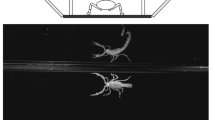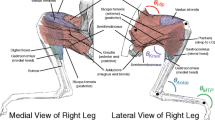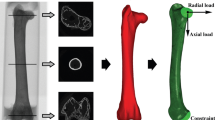Abstract
Previous studies showed that birds primarily use their hindlimbs to propel themselves into the air in order to take-off. Yet, it remains unclear how the different parts of their musculoskeletal system move to produce the necessary acceleration. To quantify the relative motions of the bones during the terrestrial phase of take-off, we used biplanar fluoroscopy in two species of birds, diamond dove (Geopelia cuneata) and zebra finch (Taeniopygia guttata). We obtained a detailed 3D kinematics analysis of the head, the trunk and the three long bones of the left leg. We found that the entire body assisted the production of the needed forces to take-off, during two distinct but complementary phases. The first one, a relatively slow preparatory phase, started with a movement of the head and an alignment of the different groups of bones with the future take-off direction. It was associated with a pitch down of the trunk and a flexion of the ankle, of the hip and, to a lesser extent, of the knee. This crouching movement could contribute to the loading of the leg muscles and store elastic energy that could be released in the propulsive phase of take-off, during the extension of the leg joints. Combined with the fact that the head, together with the trunk, produced a forward momentum, the entire body assisted the production of the needed forces to take-off. The second phase was faster with mostly horizontal forward and vertical upward translation motions, synchronous to an extension of the entire lower articulated musculoskeletal system. It led to the propulsion of the bird in the air with a fundamental role of the hip and ankle joints to move the trunk upward and forward. Take-off kinematics were similar in both studied species, with a more pronounced crouching movement in diamond dove, which can be related to a large body mass compared to zebra finch.





Similar content being viewed by others
References
Abourachid A (1993) Mechanics of standing in birds—functional explanation of lameless problems in giant turkeys. Br Poult Sci 34(5):887–898. https://doi.org/10.1080/00071669308417649
Abourachid A, Hackert R, Herbin M, Libourel PA, Lambert F, Gioanni H, Provini P, Blazevic P, Hugel V (2011) Bird terrestrial locomotion as revealed by 3D kinematics. Zoology 114(6):360–368. https://doi.org/10.1016/j.zool.2011.07.002
Alexander R (1988) Elastic mechanisms in animal movement. Cambridge University Press, Cambridge
Alexander RM (1984) Elastic energy stores in running vertebrates. Am Zool 24(1):85–94. https://doi.org/10.1093/icb/24.1.85
Alexander RM (1995) Leg design and jumping technique for humans, other vertebrates and insects. Philos Trans Royal Soc London B Biol Sci 347(1321):235–248. https://doi.org/10.1098/rstb.1995.0024
Allen V, Paxton H, Hutchinson JR (2009) Variation in center of mass estimates for extant sauropsids and its importance for reconstructing inertial properties of extinct archosaurs. Anat Rec 292(9):1442–1461. https://doi.org/10.1002/ar.20973
Baumel JJ (1993) Handbook of avian anatomy: nomina anatomica avium. Publications of the Nuttall Ornithological Club (USA) no 23
Baumel JJ, King AS, Breazile JE, Evans HE, Vanden Berge JC (1993) Myology In: Handbook of avian anatomy: nomina anatomica avium. Second edition Publications of the Nuttall Ornithological Club 23:189–247
Berg AM, Biewener AA (2010) Wing and body kinematics of takeoff and landing flight in the pigeon (Columba livia). J Exp Biol 213(10):1651–1658. https://doi.org/10.1242/jeb.038109
Bilo D, Bilo A (1983) Neck flexion related activity of flight control muscles in the flow-stimulated pigeon. J Comp Physiol 153(1):111–122. https://doi.org/10.1007/BF00610348
Bonser RHC, Rayner JMV (1996) Measuring leg thrust forces in the common starling. J Exp Biol 199(Pt 2):435–439
Brackenbury J (1992) Insects in flight. Blandford,
Brainerd EL, Baier DB, Gatesy SM, Hedrick TL, Metzger KA, Gilbert SL, Crisco JJ (2010) X-ray reconstruction of moving morphology (XROMM): precision, accuracy and applications in comparative biomechanics research. J Exp Zool Part A-Ecol Genet Physiol 313A:262–279
Card G, Dickinson M (2008) Performance trade-offs in the flight initiation of Drosophila. J Exp Biol 211(3):341–353. https://doi.org/10.1242/jeb.012682
Cavagna G, Saibene F, Margaria R (1964) Mechanical work in running. J Appl Physiol 19:249–256. https://doi.org/10.1152/jappl.1964.19.2.249
Dudley R (2002) The biomechanics of insect flight: form, function, evolution. Princeton University Press
Earls KD (2000) Kinematics and mechanics of ground take-off in the starling Sturnis Sturnus vulgaris and the quail Coturnix coturnix. J Exp Biol 203(Pt 4):725–739
Fischer MS, Schilling N, Schmidt M, Haarhaus D, Witte H (2002) Basic limb kinematics of small therian mammals. J Exp Biol 205(Pt 9):1315–1338
Gatesy SM (1999) Guineafowl hind limb function. I: Cineradiographic analysis and speed effects. J Morphol 240(2):115–125. https://doi.org/10.1002/(SICI)1097-4687(199905)240:2<115::AID-JMOR3>3.0.CO;2-Y
Gatesy SM, Baier DB, Jenkins FA, Dial KP (2010) Scientific rotoscoping: a morphology-based method of 3-D motion analysis and visualization. J Exp Zool Part A-Ecol Genet Physiol 313A:244–261
Gidmark NJ, Staab KL, Brainerd EL, Hernandez LP (2012) Flexibility in starting posture drives flexibility in kinematic behavior of the kinethmoid-mediated premaxillary protrusion mechanism in a cyprinid fish, Cyprinus carpio. J Exp Biol 215(13):2262–2272. https://doi.org/10.1242/jeb.070516
Grood ES, Suntay WJ (1983) A joint coordinate system for the clinical description of three-dimensional motions: application to the knee. J Biomech Eng 105(2):136–144. https://doi.org/10.1115/1.3138397
Hancock JA, Stevens NJ, Biknevicius AR (2007) Whole-body mechanics and kinematics of terrestrial locomotion in the Elegant-crested Tinamou Eudromia elegans. Ibis 149(3):605–614. https://doi.org/10.1111/j.1474-919X.2007.00688.x
Henry HT, Ellerby DJ, Marsh RL (2005) Performance of guinea fowl Numida meleagris during jumping requires storage and release of elastic energy. J Exp Biol 208(17):3293–3302. https://doi.org/10.1242/jeb.01764
Heppner FH, Anderson JGT (1985) Leg thrust important in flight take-off in pigeon. J Exp Biol 114:285–288
Hutchinson JR (2000) Adductors, abductors, and the evolution of archosaur locomotion. Paleobiology 26(4):734–751. https://doi.org/10.1666/0094-8373(2000)026<0734:AAATEO>2.0.CO;2
Imai T, Moore ST, Raphan T, Cohen B (2001) Interaction of the body, head, and eyes during walking and turning. Exp Brain Res 136(1):1–18. https://doi.org/10.1007/s002210000533
Kambic RE, Roberts TJ, Gatesy SM (2014) Long-axis rotation: a missing degree of freedom in avian bipedal locomotion. J Exp Biol 217(15):2770–2782. https://doi.org/10.1242/jeb.101428
Manzanera RJ, Smith H (2015) Flight in nature I: take-off in animal flyers. Aeronaut J 119(1213):257–280. https://doi.org/10.1017/S0001924000010472
Maurice M, Gioanni H, Abourachid A (2006) Influence of the behavioural context on the optocollic reflex (OCR) in pigeons (Columba livia). J Exp Biol 209(2):292–301. https://doi.org/10.1242/jeb.02005
Pennycuick CJ (1975) Mechanics of flight. In: Farner DS, King JR (eds) Avian biology, vol 5. Academic, New York, pp 1–75. https://doi.org/10.1016/B978-0-12-249405-5.50009-4
Provini P, Goupil P, Hugel V, Abourachid A (2012a) Walking, paddling, waddling: 3D kinematics Anatidae locomotion (Callonetta leucophrys). J Exp Zool 317(5):275–282. https://doi.org/10.1002/jez.1721
Provini P, Tobalske BW, Crandell KE, Abourachid A (2012b) Transition from leg to wing forces during take-off in birds. J Exp Biol 215(23):4115–4124. https://doi.org/10.1242/jeb.074484
R Development Core Team (2010) R: a language and environment for statistical computing. R Foundation for Statistical Computing
Roberts TJ (2002) The integrated function of muscles and tendons during locomotion. Comp Biochem Physiol A Mol Integr Physiol 133:1087–1099
Roberts TJ (2016) Contribution of elastic tissues to the mechanics and energetics of muscle function during movement. J Exp Biol 219(2):266–275. https://doi.org/10.1242/jeb.124446
Tobalske BW, Altshuler DL, Powers DR (2004) Take-off mechanics in hummingbirds (Trochilidae). J Exp Biol 207(8):1345–1352. https://doi.org/10.1242/jeb.00889
Warrick D, Bundle M, Dial K (2002) Bird maneuvering flight: blurred bodies, clear heads. Integr Comp Biol 42(1):141–148. https://doi.org/10.1093/icb/42.1.141
Zhang Z, Zhao J, Chen H, Chen D (2017) A survey of bioinspired jumping robot: takeoff, air posture adjustment, and landing buffer. Appl Bionics Biomech 2017:1–22. https://doi.org/10.1155/2017/4780160
Zumstein N, Forman O, Nongthomba U, Sparrow JC, Elliott CJ (2004) Distance and force production during jumping in wild-type and mutant Drosophila melanogaster. J Exp Biol 207(20):3515–3522. https://doi.org/10.1242/jeb.01181
Acknowledgements
The authors acknowledge the organisers of the XROMM course, EL Brainerd, SM Gatesy, DB Baier, and others at Brown University, RI, USA, in June 2010, for their informative course and their work for continually improving the method. We thank BW Tobalske and B Jackson for the surgery they performed on the animals, as well as KE Crandell for her support during the data acquisition. The authors would like to acknowledge the Concord field station, especially A Biewener for the accommodation and equipment access as well as his remarks on the draft of the manuscript. Thanks to I Ross for his help with the CT scan acquisition at the Harvard facilities. The authors want to acknowledge the anonymous reviewers whose comments significantly improved the paper.
Funding
This research was supported by grants from the UMR 7179, lʼAction Transversale du Muséum National dʼHistoire Naturelle formes possibles, formes réalisées and from Ecole Doctorale Frontières du Vivant and Bettencourt-Schueller Foundation fellowships. Travels were paid by the UMR 7179.
Author information
Authors and Affiliations
Corresponding author
Additional information
Communicated by: Sven Thatje
Electronic supplementary material
Supplementary Material 1
Resultant forces profiles in Diamond Dove (a) and Zebra Finch (b) during take-off, modified from Provini et al. (2012b). (PDF 39 kb)
Supplementary Material 2
Location of the implanted markers (in black) and virtual markers (in red) on the head (a), the pelvis (b), the left femur (c), left tibiotarsus (d) and left tarsometatarsus (e).The size of the markers has been magnified to facilitate their identification on the figure. (PDF 765 kb)
Supplementary Material 3
Video of the terrestrial phase of take-off of a Diamond Dove and a Zebra Finch (WMV 7349 kb)
Supplementary Material 4
ACS (a-f), JCS conventions (h) for each bones and reference pose (g). Craniolateral and lateral view of the head ACS (a), craniolateral and lateral view of the trunk ACS (b), craniolateral and lateral view of the left acetabular ACS (c), craniolateral and dorsal view of the femur ACSs (d), craniolateral and dorsal view of the tibiotarsus ACSs (e), craniolateral and dorsal view of the tarsometatarsus ACSs (f). Craniolateral and dorsal views of the reference pose (g), showing the JCSs axes when all translations and rotations are 0. To differentiate the bones that are overlapping we used several colours (orange for the head, light yellow for the trunk, yellow for the femur, white for the tibiotarsus, light yellow for the tarsometatarsus). Anterolateral view of the head, trunk and hindlimbs showing the joint coordinate systems (JCSs) (h) by which flexion-extension (blue), abduction-adduction (green) and long-axis rotations (red) were measured at the hip, knee and ankle and by which antero-posterior (red), left-right (green) and ventro-dorsal (blue) translations, as well as yaw (blue), pitch (green) and roll (red) were measured at the head and pelvis. (PDF 1077 kb)
Supplementary Material 5
Segmented regressions calculated on Trtx (red) and Trtz (blue) through take-off sequence in each trial of Diamond Dove take-off (a) and Zebra Finch (b). Breakpoint value is indicated as well as the r 2 of the segmented regression for each trial. (PDF 151 kb)
Supplementary Material 6
Mean velocities calculated on the Trunk vertical and horizontal translations. Means are represented with a solid line, the envelop represents standard deviation, for Diamond Dove (a) on the left and Zebra Finch (b). (PDF 59 kb)
Rights and permissions
About this article
Cite this article
Provini, P., Abourachid, A. Whole-body 3D kinematics of bird take-off: key role of the legs to propel the trunk. Sci Nat 105, 12 (2018). https://doi.org/10.1007/s00114-017-1535-8
Received:
Revised:
Accepted:
Published:
DOI: https://doi.org/10.1007/s00114-017-1535-8




